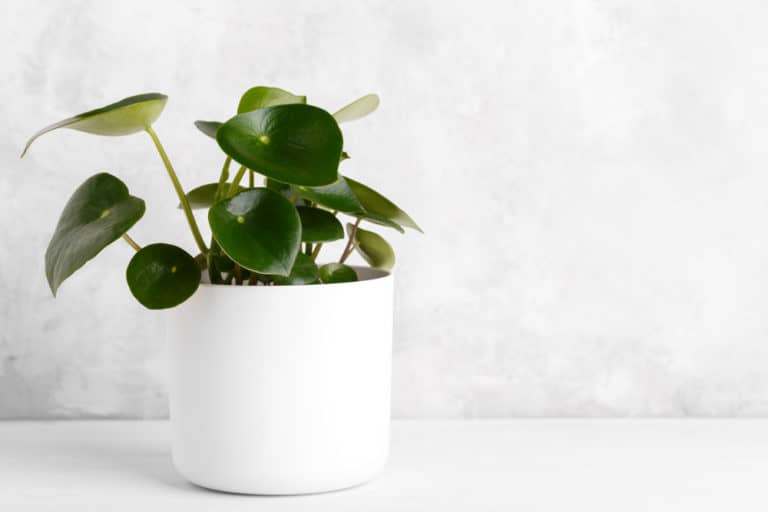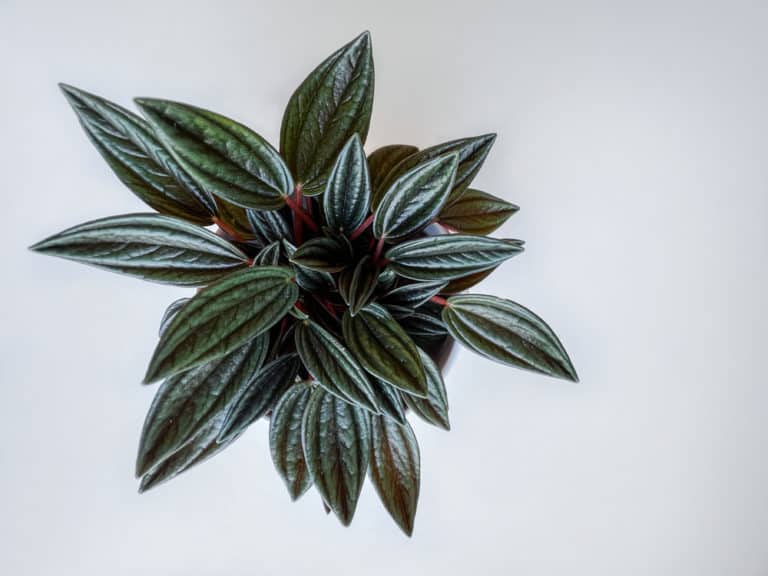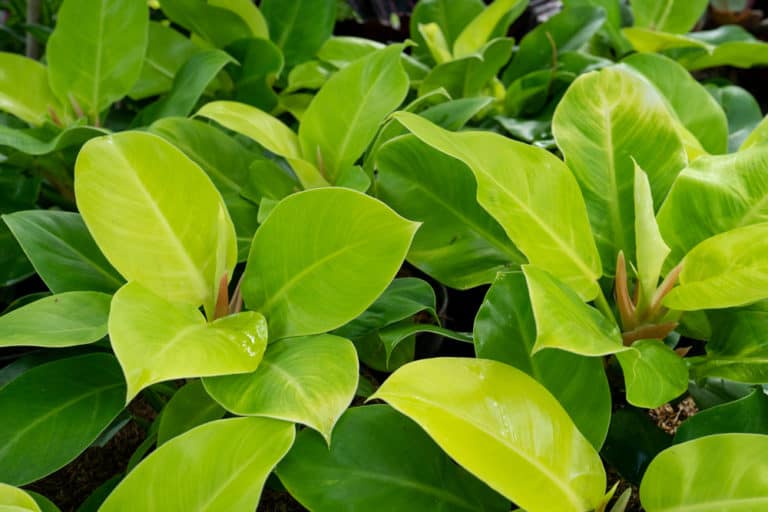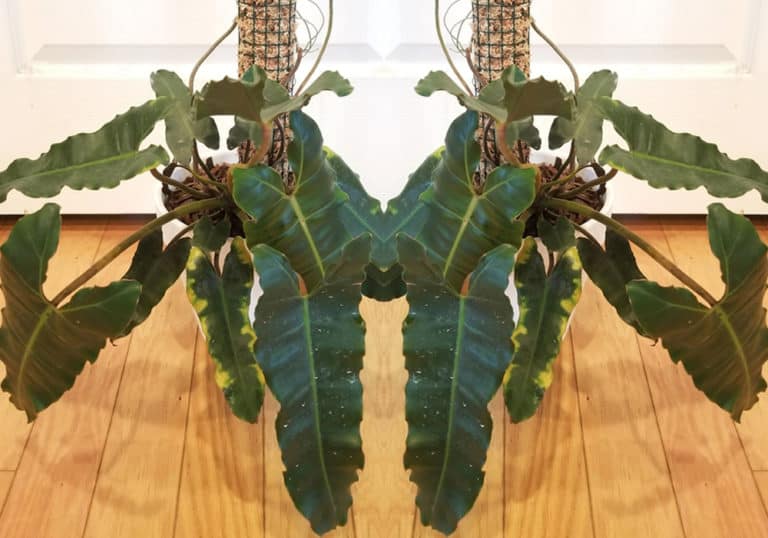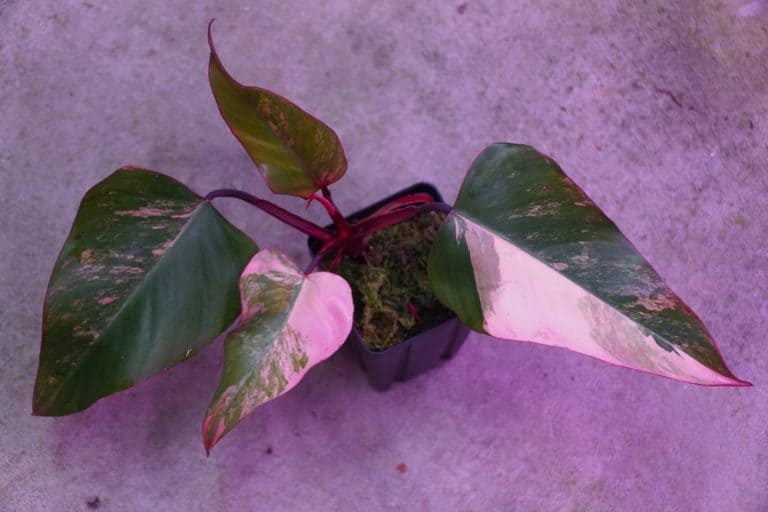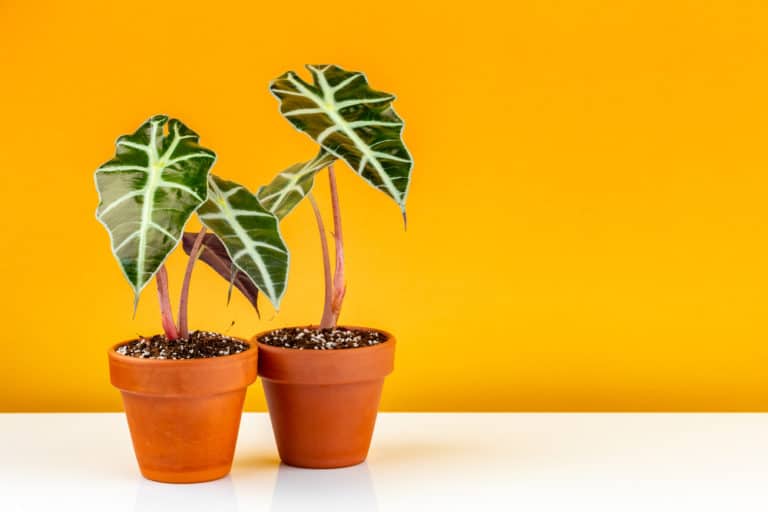Begonia Rex ‘Escargot Begonia’ Care Guide (2024)
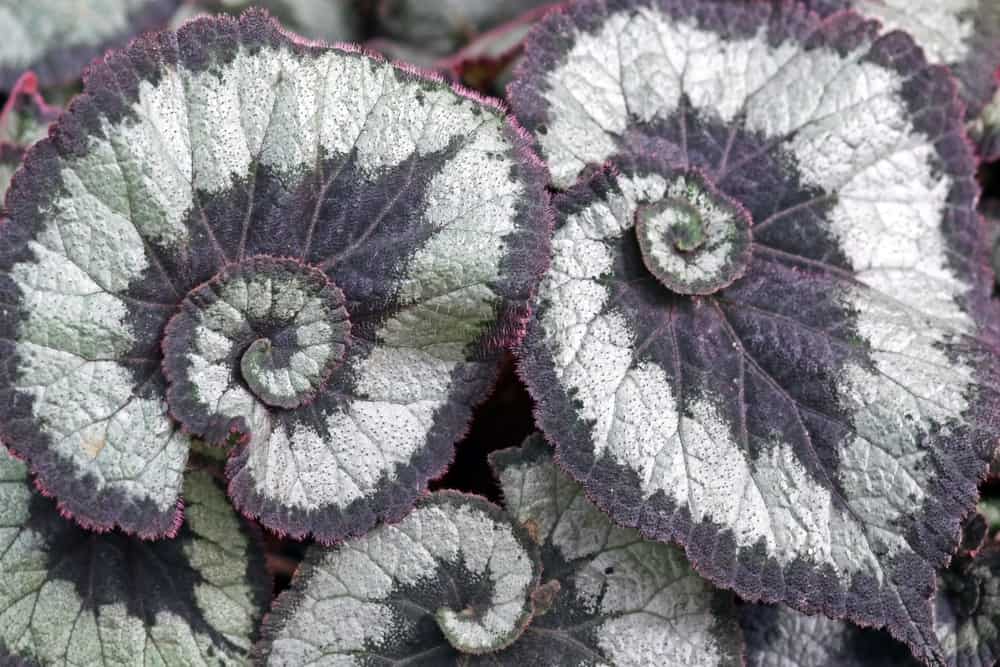
The remarkable thing about Begonia rex is its foliage. The dramatic appearance of each leaf featured a hairy surface, prominent veins, and bright colors. Its beautiful variegations are the reason why it’s called painted-leaf begonia.
Escargot Begonia is best grown outdoors. Some gardeners consider it to be high-maintenance when it comes to the watering regime.
| Scientific Name | Begonia rex |
| Common Name | Rex Begonia, King Begonia, Painted-leaf Begonia, Beefsteak |
| Light | Moderate to bright indirect light |
| Watering | Water weekly allowing the top inch of soil to dry out between waterings |
| Temperature | 60 to 70oF (15.56 – 21.11oC) |
| Hardiness Zone | 10 – 12 |
| Humidity | 50% or more |
| Soil Type | Well-drained, light, sandy, porous |
| Soil pH | 5.7-6.2 (more acidic) |
| Fertilizing | Use liquid fertilizer weekly at quarter strength or at half strength every two weeks |
| Repotting | Any time of year but is best during spring |
| Pruning | Any time during spring or early summer when the begonia is in its active growth cycle |
| Propagation | Stem Cutting, Leaf Cutting, Division |
| Toxicity | Cats, Dogs, and Horses |
| Mature Size | 0.3 m to 0.5 m |
| Bloom Time | Flowers not showy, summer to frost |
What’s Unique About Begonia rex?
There are about 2,000 species of plants found under the Begonia genus. But among such a huge number, the Begonia rex plant is unique because of its extraordinary beauty. The leaves are very fancy looking as they look like they’ve been hand-painted.
This particular Begonia species is native to southeast China and northwestern India, making them tropical in nature. They belong to the rhizomatous types of begonia as they’re characterized to have thick, fleshy roots. They’re relatively short plants. Hence, it’s best to grow them in pots.
Although it’s also a flowering plant, Begonia rex plants are more valuable for their foliage.
Begonia rex Care
Begonia rex plant care is a bit tricky. Although it’s relatively easy to grow, you have to be careful when it comes to watering. This plant is unforgiving when overwatered. Aside from that, you must also provide dappled light and moderate to high humidity. Hence, diligence is the key to finding success in escargot Begonia care.
Light
A light shady spot will satisfy your Begonia rex light requirements. If planted outdoors, it’s best to place it in locations where it receives dappled light. You can subject it under the full sun but only for a short period of time. Then, bring it under shade for about 4 to 6 hours.
If it’s planted indoors, place it in an area where there’s bright indirect light. Begonia rex can tolerate lesser light compared to other begonia species. It’s even fine to use fluorescent as a light source. Just place it 6 to 12 inches away from your plant to properly achieve your escargot Begonia light needs.
Watering
Begonia rex watering is by far the most challenging part. If you make a mistake, it may cost the life of your beautiful begonia plant. You have to keep the soil evenly moist. However, you must strike a balance in order not to leave the soil soaking wet. Otherwise, your plant may end up getting root rot.
To keep it safe, water escargot Begonia only when the top 2.5 inches of the soil surface gets dry. You can insert your finger into the soil to check. After watering, allow excess water to drain. If you’re able to satisfy the plant’s watering needs, expect that it’ll flourish.
Temperature
As a species that loves a warm environment, the Begonia rex temperature range should be between 65-75°F (18-24°C). Beware of cold spells as the plant’s temperature tolerance won’t go beyond 60°F (16°C). In the event that your begonia is exposed to low temperatures, they may suffer temperature stress and drop their leaves.
To avoid this unfortunate event, it would be best to plant your Begonia rex in areas under USDA hardiness zones 10 to 12. It would also help to keep your plant away from chilly windows and transfer it to a warm location during the night. Achieving the right temperature for escargot Begonia is crucial to helping the plant grow and develop optimally.
Humidity
Your Begonia rex humidity requirements would range from moderate to high, 50% and above. If you’re living in tropical and sub-tropical places, this isn’t hard to achieve when the plant is placed outdoors. However, in indoor settings, there can be some struggle.
What you can do to attain the ideal humidity for escargot Begonia indoors is to place it in humid locations like the kitchen or the bathroom. Such areas are naturally moist and would provide the humidity level that your plant requires.
In cases when the air gets really dry, you can use a humidifier or a pebble tray.
Soil
Begonia rex would thrive best in a peat-based soil mix. This media is somewhat acidic making it favorable for the plant. However, anything between 5.7 to 6.2 ph level for escargot Begonia would be fine.
It’s crucial to ensure proper drainage for Begonia rex soil to prevent root rot. Aside from digging enough drainage holes, you must also use the right combination of soil amendments. Include peat moss, perlite, and vermiculite as ingredients.
Another hack to achieve good drainage of your soil for escargot Begonia is to add a layer of pebbles at the pot’s bottom. This would prevent water from getting stagnant.
Fertilizer
Of course there’s a need to apply Begonia rex fertilizer. The additional feed is beneficial for the plant to stay well-nourished. You have the choice to apply fertilizer every week or every two weeks depending on your plant’s needs. Just make sure to dilute it to half or quarter strength. Using the correct fertilizer ratio will prevent your begonia from getting overfertilized.
Refrain from adding fertilizer for escargot Begonia during the winter months as they’re in a dormant stage. This time they’re on rest and there’s very little physiological activity going on. Application of fertilizer on dormant plants might just harm the roots leading to damage.
Potting & Repotting
It may take about 1 to 2 years before you could repot your Begonia rex. This plant loves to be pot-bound so you have to wait for the rhizomes to fill the container. Repotting escargot Begonia can be stressful to the plant. Hence, you have to do it with caution.
Remove the plant from its current pot careful not to damage the roots. Shake off the old potting medium. Prepare a fresh potting mix. Transfer to a new container with a pot size that’s a bit larger than the previous. Fill it in with potting mix and water it well.
Normally, leaves will droop after Begonia rex repotting. So, make sure to place it in a shaded area.
Pruning
Begonia rex pruning is just an occasional event. It doesn’t have to be frequent. You just have to watch out for leggy stems that you could trim. This would encourage fuller growth of the entire plant. Also, look for dead or decaying leaves and snip them away.
Cutting escargot Begonia is also advisable in autumn after the plant has finished flowering. Doing so will help conserve the plant’s energy when the winter season comes. As a result, the plant will grow back healthily next year.
Remember to always use a sterilized pruning shear or scissor every time you do pruning.
Propagation
Thankfully, it’s a lot easier to propagate escargot Begonia because of the presence of its rhizomes. You can multiply the plant through the division of the mother plant. This is the most efficient method that you could use. During repotting, you could divide the rhizomes into two or three, depending on how thick it is. You can pot each divided portion so it grows as an individual plant.
However, there are also other ways to do Begonia rex propagation. Such includes stem cuttings and leaf cuttings. You can use a rooting hormone to hasten the root formation of the propagated cuttings.
Also, make sure to check out our in-depth beefsteak Begonia plant care guide.
Common Problems of Begonia rex
Growing Begonia rex is not always an easy feat. It’s natural to encounter some problems with escargot Begonia in every stage of its growth and development. Commonly, pests and diseases are present, making their signs and symptoms visible on the leaves.
Some of these common Begonia rex problems are as follows:
Pests
The species that you’ll encounter as Begonia rex pests are pretty common. If you’re a gardener of ornamental plants, you’re probably familiar with most of them. Bugs such as scales, and mealybugs are there. Others include whiteflies and thrips. The common thing about them is that they’re tiny and hard to notice. Plus, they damage the plant by sucking sap from the plant tissues.
When it comes to pest management, early detection is crucial. Make sure to always inspect your escargot Begonia plant. Once you notice the presence of these pests, take action to get rid of them. Isolate your plant while treating it with horticultural oils or diluted dishwashing soap.
Diseases
Some serious diseases could lead to the death of your escargot Begonia. Hence, we don’t want any of them to get in touch with disease-causing organisms. Root rot, powdery mildew, and gray mold are just among the common diseases to watch out for.
Root rot is a result of overwatering which also favors the growth of soil-borne pathogens. Powdery mildew is the presence of white deposits on the undersides of stems and leaves. Gray mold creates patches on the leaf surface, which is often triggered when there’s less humidity.
To combat these Begonia rex diseases, isolate the diseased plant and trim the infected portions. Adjust certain factors in the environment to achieve the ideal conditions. Apply fungicide if necessary.
Growing Problems
Wilting or drooping leaves is one of the most visible problems in growing Begonia rex. But that is just a result of a deep-seated issue. Watering problems (overwatering or underwatering), lack of light or too much of it, low humidity, or even pests and diseases can make a sick plant.
These growing problems are most likely brought about by unfavorable environmental conditions. Hence, you have to be mindful of the environment. Try to avoid stressful circumstances at all costs so your plant will live happily.
Be quick to address the first signs of the problems. That way, you’ll prevent the issues from blowing up.
Toxicity of Begonia rex
According to APSCA, escargot Begonia is toxic to both cats and dogs along with other species of begonia plants. Toxicity will take its effect once you consume the plants or their tubers. Thus, you can’t get hurt by simply handing the plant. Although it’s considered toxic to pets and humans, it will not necessarily lead to death.
For Humans
It is true that Begonia rex has toxic properties. While it’s non-fatal, it would be unwise to handle this plant complacently. It contains soluble calcium oxalates that could irritate the skin of humans. This is why it’s always advisable to wear gloves and wash your hands after having direct contact with the plant sap.
Strictly warn your children not to toy with the plant. We want to prevent them from consuming any portion of the plant to avoid poisoning. To be sure, place your Begonia rex away from the reach of your kids. That simple gesture could save you a lot of trouble in the future.
For Pets
In the same way, pets are also unsafe when there’s a Begonia rex around especially if they have a habit of eating your plant’s leaves. Irritation can occur such as salivation and vomiting. It could also lead to kidney failure.
The most toxic part of Begonia rex is its underground part, known as the rhizomes. So, you must beware not to let your pets ingest this specific part. If they happen to do so, make immediate consultation with your vet.
The best way to avoid poisoning is to keep your plant in an area that your dogs or cats can’t reach.
Begonia rex Appearance
The Begonia rex appearance is characterized by a wide range of colors, textures, and shapes depending on its variety. For that reason, the plant looks adorable and unique. It’s a short perennial shrub perfect as a potted ornamental plant. The attractive foliage is gorgeous enough to turn someone in awe.
Let’s get more into detail.
Foliage
Being its most valuable asset, the foliage of Begonia rex has a lot to offer. It comes in unique shapes of hearts, seashell swirls, and ivy-like forms. Those leaves are usually broad and large having an average size of 12 cm each. The leaf surface is also heavily decorated in various colors. Most often, it’s a mixture of green, pink, burgundy, and metallic shades of gray and silver.
The texture of the leaf is slightly rough due to the presence of tiny hairs. The variegations are more defined when there are ideal growing conditions such as proper light, enough humidity, and correct temperature.
Flowering
In contrast to its gorgeous leaves, the Escargot Begonia flower is not much of an attraction. Although they bloom continuously from summer to frost seasons, such flowers are tiny in size and mostly go unnoticed. They have a bilateral shape and a blush pink color. These flowers usually come in clusters.
Other ornamental plants require much light to bloom. But that is not the case for rex begonia. Even when the plant is under partial shade, Begonia rex flowering will still occur. You just have to provide a small amount of fertilizer. It will keep the plant blooming through the seasons.
Size and Growth
The mature size of Begonia rex can reach from 12 to 18 inches tall. Similarly, its spread can also reach the same size. If the plant is properly pruned, it will create a perfect proportion wherein lateral growth matches that of vertical growth.
Other than being a small shrub, this plant has a moderate growth rate, too. If yours is newly planted, expect it to grow less than 12 inches after a year. But that’s totally fine and normal. Just make sure that the growing condition is ideal. That way, your plant will remain vigorous even when there’s not much growth happening.
Begonia rex Fragrance
There is nothing much to expect about Begonia rex fragrance. However, that’s understandable since most begonia species are not scented. That includes this species. But that’s totally fine because even without a special scent, your painted leaf begonia will remain desirable in its own way.
If you want to have sweet-scented begonia, we suggest that you add the tea rose begonia in your collection. This species has a light but sweet fragrance that’s noticeable. Aside from its air-purifying nature, it would be best to have a pot of fragrant begonia. That would surely add a sweet scent to your home.
Suggested Uses for Begonia rex
There are many ways to use your Begonia rex plant. It’s best to have it potted in small containers to display either outdoors or indoors. Apart from that, you can also use it as bedding plants in your landscapes or in window boxes. If you want hanging plants, Begonia rex is also a great option.
You can combine different varieties of Begonia rex to achieve a combination of colorful hues. That would make a spectacular display for sure. Another option is to place it at the center table in your living room or kitchen countertops to serve as a colorful accent.
Begonia rex Varieties
The begonia genus in itself already offers a wide range of selections. And we know that Begonia rex is by far one of the most attractive species. But among this group, there are many Begonia rex varieties to choose from as well. You can see variations in their leaf colors and variegation pattern.
Choosing the types of escargot Begonia can be a little confusing, especially if you don’t have an idea how each one differs from another. To help you figure out, let’s go explore and see which ones are most popular among gardeners. Take note of their cultivar names.
Begonia rex ‘Red Kiss’
Red Kiss is a small cultivar of Begonia rex. It has smaller leaves with a color of bright metallic red and black on its edges. It also has a large black color on its center.
Begonia rex ‘Silver Limbo’
As its name implies, the Silver Limbo has metallic silver color on its surface while it’s red on the underside. The leaf shape is narrow and pointed. Like the Red Kiss, the leaves are also small.
Begonia rex ‘Spitfire’
Spitfire is an exotic variety because of its reddish pink leaves marked with silver and green on its edges. It grows a little smaller reaching only about 8 inches when mature.
Begonia rex ‘Tornado’
The distinct thing about Begonia rex ‘Tornado’ is that it has spiraled leaves that are silver in color. On top of it is a purple black markings making it appear bold.
Begonia rex ‘Ballet’
Ballet has a distinct reddish stem. It’s leaves are silvery green in color while its edges have a mid-green tone. Like the Spitfire, its size can reach up to 8 inches high and wide.
FAQ
What is Begonia rex?
This semi-tropical perennial plant originates from southeast China and northwestern India. It offers colorful foliage and is one of the most interesting indoor plants around. Sometimes called painted-leaf begonias, it’s known for their variegated leaves.
How to identify Begonia rex?
Look at its leaves. The shapes vary from hearts to seashell swirls, to ivy-like forms. Also check for its leaf’s color. It’s often a mix of green, pink, or burgundy and metallic shades of grayish silver.
How to care for Begonia rex?
Water once a week in summer and once every 2 weeks in winter. Place in a partly shaded area. Feed once a month in the summer. Ensure moderate to high humidity.
How to grow Begonia rex indoors?
Keep soil evenly moist and reduce water in winter. Avoid waterlogged soil. When the plant is in full growth, fertilize with balanced liquid fertilizer at half strength at alternate waterings.
How to grow Begonia rex outdoors?
It can grow outdoors year-round under USDA hardiness zones 10 and 11, enjoying the heat of the summer. In cooler areas, bring them outdoors in the summer and place them indoors in the fall.
How fast does Begonia rex grow?
It’s one of the easiest houseplants to care for. You can expect to see growth in 3-6 weeks’ time, depending upon your overall growing conditions.
How tall does Begonia rex grow?
A mature plant reaches 12 to 18 inches tall and wide. The leaves of rex begonias grow clumped together, the plant is dense looking and rounded.
How to make Begonia rex grow faster?
Provide the most ideal growing conditions like sufficient light, water and humidity. Add fertilizer for regular nutrient supply. Provide a warm temperature for growth and development.
How to stake Begonia rex?
Tall-growing and heavy begonia will require fairly strong stakes to support the weight of large leaves and blossom. Use a longer stake so you can tie the stems to it.
How to pot Begonia rex?
Divide the rhizome when repotting to increase your plant stock. As with all begonias, don’t soak the soil of newly potted plants, but do keep it lightly moist and warm.
How to revive Begonia rex?
The first step is to know what exactly is the problem. From there, you can devise solutions based on what causes trouble on your plant.
Why is my Begonia rex dying?
Underwatering is one of the most likely reasons your begonia is wilting. Underwatering results in dry soil. This means that the plant may not get enough water and nutrients.
Why is my Begonia rex drooping?
The major cause of drooping may be overwatering and underwatering. Either it wilts due to lack of moisture or it droops due to root rot.
How cold can Begonia rex tolerate?
Temperatures lower than 60oF (16°C) will damage rex begonia. Growth will slow in freezing temperatures as they go into a dormant period during the winter.
How to get rid of pests on Begonia rex?
You can eliminate majority of the pests in Begonia rex thru application of neem oil or insecticidal soap. A blast of water from a hosepipe is also effective.
Is Begonia rex toxic to cats?
Yes, it’s toxic to your cat. Better be careful for your cat not to ingest its parts. Once ingested, symptoms like inability to swallow, salivation, sores and vomiting will show.
Is Begonia rex toxic to dogs?
Yes. So, it’s best to train your fur babies to stay away from this plant. Once ingested, it may cause some drooling, difficulty swallowing, and vomiting.
Is Begonia rex toxic to children?
Keep this plant out of your children’s reach. Begonia rex can be poisonous if accidentally consumed by curious kids. Warn them not to eat any portion of this plant.
Is Begonia rex toxic to humans?
Begonia rex can also be poisonous to humans once ingested. It may cause also irritation on the skin due to calcium oxalates present in the plant’s tissues.
Does Begonia rex have a scent?
Neither the leaves nor the tiny flowers of Begonia rex emit any notable fragrance. So, it’s safe to assume that it doesn’t have a scent.

